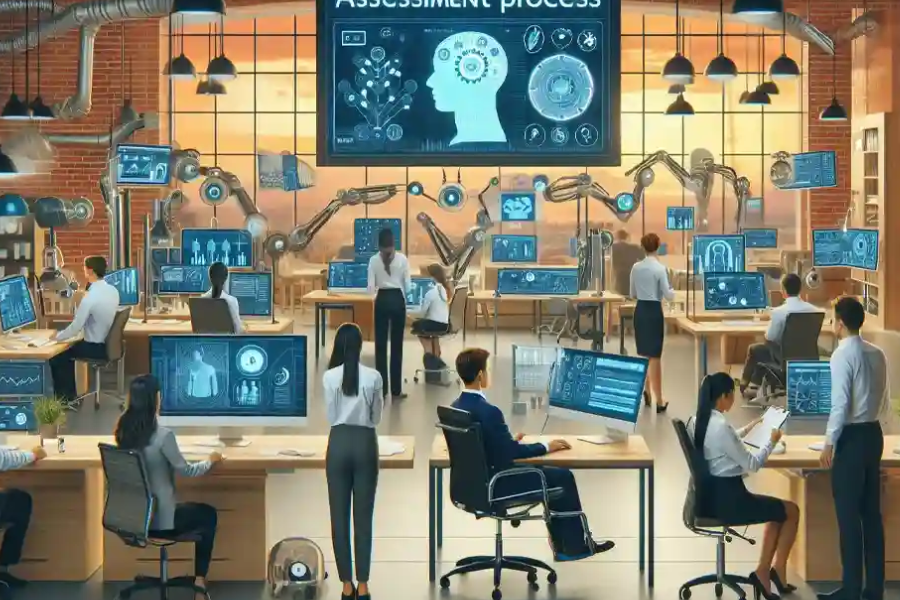Empowering Independence: The Assistive Work Technology Assessment at Roosevelt Warm Springs
Nestled in the peaceful landscape of Georgia, Roosevelt Warm Springs is more than a historic rehabilitation center—it’s a place where individuals with disabilities rediscover their independence and transform their lives. Among its many innovative programs,Assistive Work Technology Assessment at Roosevelt Warm Springs, helps people overcome challenges in the workplace with tailored technological solutions.
A Place Where Technology Meets Possibility
Imagine stepping into a space where growth and support are not just ideals but realities. At Roosevelt Warm Springs, this vision comes to life as experts collaborate closely with each individual, carefully assessing their needs to provide customized solutions. Whether through specialized software or adaptive devices, each assessment is designed to open doors to new possibilities, helping clients achieve their professional goals.
Understanding Assistive Work Technology
Assistive Work Technology Assessment at Roosevelt Warm Springs encompasses a range of tools and devices crafted to support individuals with disabilities in their professional environments. These technologies enable users to perform tasks with greater efficiency, fostering both independence and productivity. From screen readers that assist those with visual impairments to ergonomic keyboards designed for individuals with mobility challenges, these innovations create a more inclusive and capable workforce.
Beyond merely removing obstacles,Assistive Work Technology Assessment at Roosevelt Warm Springs,allowing people to contribute meaningfully to their work. Organizations that embrace these technologies tap into a diverse talent pool, fostering a culture of acceptance and inclusion.
The Benefits of Assistive Work Technology
For individuals with disabilities, Assistive Work Technology Assessment at Roosevelt Warm Springs.By customizing tasks to suit unique needs, these technologies empower users to reach their full potential. Accessibility features such as voice recognition and adaptive keyboards make interacting with computers and other devices seamless, enhancing both confidence and independence.
This technology also fosters collaboration, ensuring that all team members, regardless of physical limitations, can engage effectively. The result is an inclusive environment where diversity is not only accepted but celebrated. Companies that invest in assistive technology often see improved employee retention, as these tools enhance job satisfaction and loyalty.
The Assessment Process at Roosevelt Warm Springs
At Roosevelt Warm Springs, the Assistive Work Technology Assessment at Roosevelt Warm Springs with a thorough evaluation of each individual’s needs. The process is highly personalized, ensuring that every participant receives the support they require. Skilled professionals conduct interviews and skill assessments, gathering insights into the individual’s abilities, challenges, and career aspirations. This information is crucial in identifying the most suitable technological solutions.
Once the data is collected, specialists recommend specific tools designed to enhance the individual’s productivity and independence. Participants can trial these devices in real work settings, providing feedback that allows for further customization. This collaborative approach ensures that the technology seamlessly integrates into the user’s life, empowering them to thrive professionally.
Inspiring Success Stories
Roosevelt Warm Springs is home to numerous success stories, each demonstrating the profound impact of Assistive Work Technology. Take, for instance, Sarah, a young woman who was matched with specialized software tailored to her visual impairment. With this technology, she excelled in data entry tasks, regaining her confidence and independence in the workplace.
Another inspiring story is that of Mark, who faced significant mobility challenges. After receiving tailored ergonomic equipment and assistive devices, he transformed his workstation into an accessible environment, boosting both his productivity and job satisfaction. These stories illustrate how personalized technological solutions can break down barriers and empower individuals with disabilities to achieve their goals.
Overcoming Challenges in Assistive Work Technology
While the benefits of Assistive Work Technology Assessment at Roosevelt Warm Springs, there are also challenges to consider. One of the most significant barriers is cost—high-quality equipment can be expensive, making it difficult for some individuals and organizations to access these tools.
Keeping up with the rapid pace of technological change is another challenge. As new tools emerge, users and providers alike must navigate the complexities of training and support. Compatibility issues can also arise, as not all workplaces have systems that integrate smoothly with assistive technology, leading to frustration and inefficiency.
Additionally, some individuals may be hesitant to adopt new devices or software, either due to unfamiliarity or previous negative experiences. Regular maintenance is also essential to ensure that these tools continue to perform optimally in the workplace.
Looking Ahead: The Future of Assistive Work Technology
The future of Assistive Work Technology Assessment at Roosevelt Warm Springs is filled with exciting possibilities. Emerging advancements in artificial intelligence and machine learning are poised to make these tools even more personalized and accessible, creating more inclusive workplaces. Wearable devices are becoming increasingly popular, offering real-time assistance for various tasks and monitoring health metrics simultaneously.
3D printing is revolutionizing the field by enabling the rapid creation of customized tools at a lower cost, ensuring that individuals receive exactly what they need. Virtual reality (VR) training programs are also on the rise, allowing individuals to practice new skills in safe, controlled environments before transitioning to actual job settings, reducing anxiety and boosting confidence.
Conclusion
The Assistive Work Technology Assessment at Roosevelt Warm Springs is a shining example of how tailored technological solutions can empower individuals with disabilities. Through innovative tools and personalized support, this program is helping participants overcome barriers and achieve their professional dreams.
While challenges remain, including accessibility and the need to keep pace with technological advancements, the future of this field is bright. With continued dedication and innovation, Assistive Work Technology Assessment at Roosevelt Warm Springs will play an increasingly vital role in creating inclusive workplaces where everyone can thrive.
Roosevelt Warm Springs continues to lead the way, fostering a culture of empowerment and inclusivity that opens doors for countless individuals on their journey to independence and fulfillment in the workplace.
Facts:
- Location: Roosevelt Warm Springs is located in Georgia and is a historic rehabilitation center known for helping individuals with disabilities regain independence.
- Program Focus: The Assistive Work Technology Assessment program at Roosevelt Warm Springs offers customized technological solutions to help individuals with disabilities succeed in the workplace.
- Types of Technology: The program includes a variety of assistive tools, such as screen readers, ergonomic keyboards, voice recognition software, and adaptive devices.
- Personalized Approach: The assessment process is highly personalized, involving interviews, skill assessments, and trials of recommended tools in real work settings.
- Challenges Addressed: The article discusses challenges like the cost of high-quality equipment, the need for ongoing training, compatibility issues, and user hesitancy in adopting new technologies.
- Success Stories: The program has helped numerous individuals, such as Sarah, who excelled in data entry with the help of specialized software for her visual impairment, and Mark, who transformed his workspace with ergonomic equipment to overcome mobility challenges.
- Future Prospects: The article highlights the potential for emerging technologies like AI, machine learning, 3D printing, and VR to further enhance assistive work technology.
Summary:
The article “Empowering Independence: The Assistive Work Technology Assessment at Roosevelt Warm Springs” highlights the critical role of the Roosevelt Warm Springs rehabilitation center in Georgia, focusing on its Assistive Work Technology Assessment program. This program is designed to help individuals with disabilities overcome workplace challenges through tailored technological solutions. The article describes how experts at Roosevelt Warm Springs assess each participant’s needs, recommend customized assistive tools, and offer a personalized approach to ensure successful integration into professional environments. By providing these specialized technologies, the program enhances independence, productivity, and inclusivity in the workplace.
FAQs:
1. What is the purpose of the Assistive Work Technology Assessment at Roosevelt Warm Springs?
The purpose is to help individuals with disabilities overcome workplace challenges by providing customized technological solutions that enhance their independence and productivity.
2. How does the assessment process work?
The process involves a thorough evaluation of each individual’s needs, including interviews and skill assessments. Based on this information, experts recommend specific assistive tools, which participants can trial in real work settings.
3. What types of technology are used in the program?
The program uses a variety of assistive technologies, such as screen readers, ergonomic keyboards, voice recognition software, and adaptive devices tailored to the individual’s needs.
4. What are some challenges associated with assistive work technology?
Challenges include the high cost of equipment, the need for continuous training and support, compatibility issues with workplace systems, and user hesitancy in adopting new technologies.
5. How has the program impacted participants?
The program has significantly impacted participants by enabling them to perform their jobs more effectively, boosting their confidence, and helping them achieve professional success despite their disabilities.






